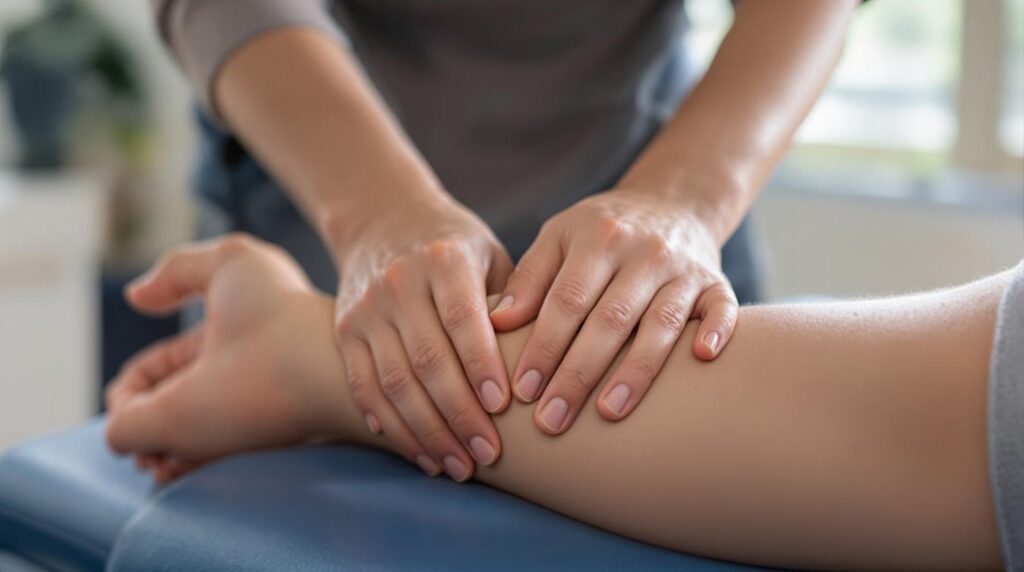You'll find relief from tendonitis through a combination of targeted exercises and massage techniques. Start with gentle self-massage using circular motions and moderate pressure, then progress to eccentric exercises that lengthen tendons under tension. Professional sports massage methods, including cross-fiber friction and trigger point therapy, can break down scar tissue and reduce inflammation. For ideal recovery, incorporate daily stretching and proper ergonomics. This all-encompassing approach offers numerous strategies to accelerate your healing process.
Understanding Tendonitis: Causes and Risk Factors
Although tendonitis can affect anyone, understanding its underlying causes and risk factors is essential for both prevention and treatment. You'll often develop this condition through repetitive movements, overuse of specific joints, or sudden increases in physical activity without proper conditioning. Common risk factors include aging, certain occupations that require repetitive motions, and participation in sports like tennis, golf, or swimming.
You're more likely to develop tendonitis if you've got poor posture, use improper technique during activities, or work in environments that strain your tendons. Medical conditions such as rheumatoid arthritis, diabetes, and obesity can also increase your susceptibility. Additionally, you'll face higher risks if you don't warm up properly before exercise or if you're taking specific medications like fluoroquinolone antibiotics. Understanding the importance of proper exercise techniques is crucial in preventing tendonitis.
Essential Self-Massage Techniques for Tendon Recovery
When it comes to managing tendonitis effectively, self-massage techniques serve as an essential component of your recovery process. You'll want to focus on gentle, circular motions around the affected tendon, applying moderate pressure with your thumbs or fingertips. Start at the point of greatest discomfort and work outward, spending 2-3 minutes on each area.
For best results, you'll need to incorporate cross-fiber friction, where you move your fingers perpendicular to the tendon's length. This technique helps break down adhesions and promotes blood flow to the injured area. You can enhance the massage's effectiveness by using anti-inflammatory oils or creams, and remember to stop if you experience sharp pain. It's best to perform these self-massage techniques 2-3 times daily, particularly after exercise or physical activity. Additionally, enhanced integration of neuromuscular science can provide further insights into effective recovery strategies.
Proven Strengthening Exercises for Tendon Health
Building strength in your tendons requires specific, scientifically-proven exercises that focus on controlled, progressive loading. You'll want to start with eccentric exercises, where you slowly lengthen the affected tendon under tension, as these have shown superior results in clinical studies. For example, if you're dealing with Achilles tendonitis, heel drops on a step are particularly effective.
As your tendon health improves, you can incorporate isometric exercises, which involve holding a static position against resistance. These exercises help reduce pain while building tendon strength. You'll then progress to heavy, slow resistance training (HSR), performing exercises like calf raises or wrist curls with weights at about 70% of your maximum capacity, moving slowly through both the concentric and eccentric phases. Additionally, integrating soft tissue therapy can further enhance recovery and promote optimal tendon function.
Professional Sports Massage Methods for Tendonitis Relief
Professional sports massage techniques complement strength training by targeting inflammation and promoting blood flow to affected tendons. You'll find that cross-fiber friction massage, where the therapist applies pressure perpendicular to the tendon's direction, can help break down scar tissue and adhesions. Deep tissue massage, combined with trigger point therapy, targets the muscle attachments around the injured tendon to reduce tension and strain.
For ideal results, you'll want to receive massage treatments 2-3 times per week during acute phases. Your massage therapist should focus on both the injured area and surrounding tissues, using techniques like effleurage to warm up the area and petrissage to increase circulation. They'll likely incorporate gentle stretching movements and myofascial release to improve range of motion and reduce pain.
Prevention Strategies and Long-Term Management Plans
To effectively prevent tendonitis recurrence, you'll need to implement a thorough management strategy that addresses both immediate risk factors and long-term joint health. Regular monitoring of your activity levels, combined with proper form during exercises, will greatly reduce your risk of re-injury.
- Incorporate daily stretching routines that target specific muscle groups around the affected tendon
- Maintain proper ergonomics at work and during recreational activities
- Schedule regular rest periods between intense physical activities
- Monitor and adjust your exercise intensity based on pain levels and recovery time
You'll need to consistently evaluate your body's response to activities and modify your approach accordingly. Remember that prevention strategies should evolve as your condition changes, and you'll want to work closely with healthcare providers to adjust your management plan when necessary.

